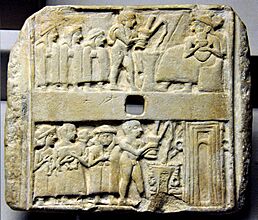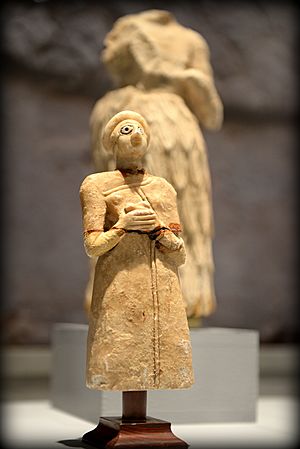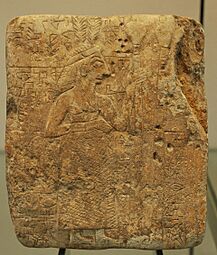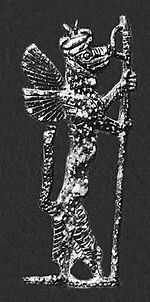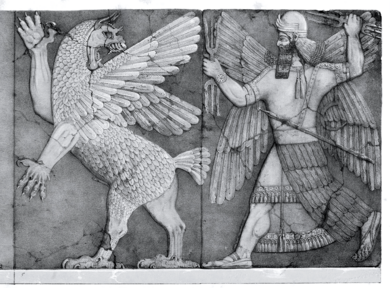Sumerian religion facts for kids
Sumerian religion was the set of beliefs held by the people of Sumer. Sumer was the first civilization in history to use writing. They lived thousands of years ago in Mesopotamia, which is in the same area as modern-day Iraq.
The Sumerians believed that their gods and goddesses were in charge of everything in the natural world and in their society. They thought the gods controlled the sun, the wind, the earth, and even how cities were run.
Contents
Beliefs and Worship
The Sumerians had a rich culture full of myths and traditions to honor their gods. Their religion was a central part of their daily lives.
Temples and Priests
In the beginning, priests were the main rulers of the Sumerian city-states. They were seen as messengers between the people and the gods. Later, kings took over as rulers, but priests still had a lot of power and influence.
Early Sumerian temples were simple, one-room buildings. Over time, they grew into huge, pyramid-like structures called ziggurats. These ziggurats had a special sanctuary at the very top, which was considered the home of the city's main god. Temples were not just for worship; they were also the centers of government and culture for a long time.
Writing and Myths
Sumerian myths and stories were passed down by word of mouth for generations. After writing was invented, these stories were written down on clay tablets using a script called cuneiform.
The earliest known myth, the Epic of Gilgamesh, was first written down by the Sumerians. At first, writing was used mostly for keeping records. But later, it was used to write down hymns to praise the gods and special chants called nam-šub.
The Sumerian Universe
The Sumerians had their own ideas about how the universe was created and what it looked like. They believed the world was a flat disc covered by a large dome.
The Creation Story
According to Sumerian myths, the universe began with a series of cosmic births.
- First, there was only Nammu, the sea.
- Nammu gave birth to An (the sky) and Ki (the earth).
- An and Ki had a son named Enlil, the god of wind and storms.
- Enlil separated the sky from the earth. He claimed the earth as his domain, while An took the sky.
The Sumerians believed that humans were created by the god Enki to serve the other gods.
Heaven and Earth
The Sumerians believed heaven was a special place where only the gods could live. They thought the sky was made of several domes made of precious stones. The stars, sun, and moon were also connected to specific gods.
- The planet Venus was linked to Inanna, the goddess of love and war.
- The sun was her brother Utu, the god of justice.
- The moon was their father Nanna.
Because heaven was just for gods, humans could not go there after they died.
The Afterlife: The Land of Kur
When a person died, the Sumerians believed their spirit went to a place called Kur. Kur was a dark, gloomy cavern deep beneath the earth. It was ruled by the goddess Ereshkigal.
Life in Kur was like a shadowy version of life on earth. Everyone went to the same afterlife, no matter if they were good or bad in life. The only food available was dry dust. To help their loved ones, family members would pour drinks into the grave through a clay pipe so the dead could have something to drink.
The entrance to Kur was thought to be in the Zagros Mountains. A soul had to pass through seven gates, guarded by a gatekeeper god named Neti. Demons called galla were said to live in Kur and would drag mortals down into the underworld.
The Gods and Goddesses
The Sumerians worshipped many gods and goddesses, a practice known as polytheism. Each god represented a different force of nature or part of life.
How Beliefs Changed Over Time
In early Sumerian history, the gods were closely tied to nature. For example, Enlil was the wind, and Enki was the fresh water. As Sumerian society grew and cities became more important, the gods started to be seen as patrons, or special protectors, of each city.
Later, when the Akkadians conquered Sumer, they blended their own gods with the Sumerian ones. During this time, male gods became more powerful, and the gods were seen as living in a society similar to human society, with kings and classes.
Meet the Main Deities
There were thousands of deities in the Sumerian pantheon, but some were more important than others.
- An was the god of the heavens and the sky. He was considered the ancestor of all the other gods.
- Enlil was the god of wind, air, and storms. He was the most powerful god and the leader of the pantheon.
- Enki was the god of water, wisdom, and creation. He was known as a friend and creator of humanity.
- Ninhursag was the goddess of the earth and fertility. She was often seen as the mother of the gods.
- Inanna was the goddess of love, beauty, and war. She was one of the most important and celebrated deities in Sumer, and many myths were written about her adventures.
- Utu was the god of the sun and justice. He was believed to protect the good and punish the wicked.
- Nanna was the god of the moon. He was the father of Utu and Inanna.
- Ereshkigal was the goddess of the underworld, Kur. She was Inanna's older sister.
Lasting Influence
Sumerian religion had a huge impact on the civilizations that came after them. Many of their myths and beliefs were adopted and changed by other cultures in the ancient Near East.
Influence on Later Civilizations
The Akkadians, Babylonians, and Assyrians all incorporated Sumerian beliefs into their own religions.
- The Babylonians adopted many Sumerian gods. For example, the Sumerian goddess Inanna became their goddess Ishtar. They also introduced a new main god, Marduk.
- The Hurrians also adopted Sumerian gods like Anu into their own pantheon.
- Many Sumerian myths, like the Epic of Gilgamesh, were retold and became famous throughout Mesopotamia.
Connections to Other Stories
Some stories from Sumerian mythology are very similar to stories found in other ancient texts, including the early parts of the Hebrew Bible.
- The Sumerian story of a great flood that wiped out humanity is very similar to the story of Noah's Ark in the Book of Genesis.
- The Sumerian underworld, Kur, shares many features with Sheol, the underworld described in the Hebrew Bible.
- Many Sumerian proverbs, or wise sayings, are similar to those found in the Book of Proverbs.
See also
 In Spanish: Religión sumeria para niños
In Spanish: Religión sumeria para niños


